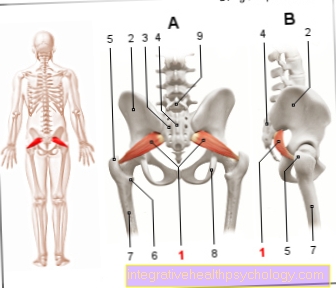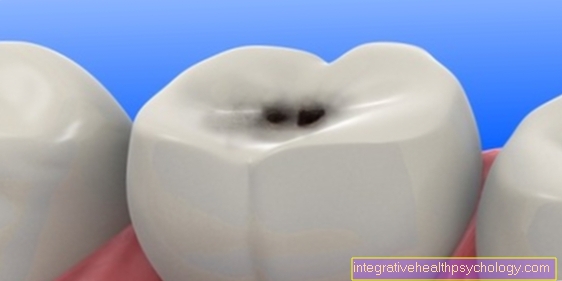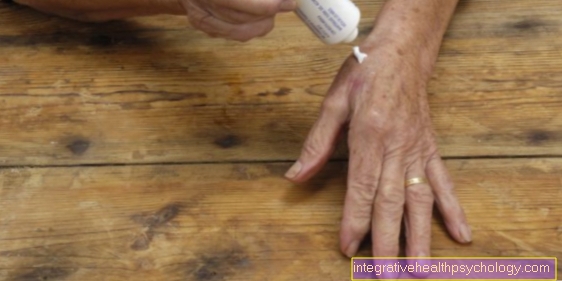Causes of Piriformis Syndrome
introduction
The piriformis syndrome is named after the piriformis muscle, which is located in the buttock area under the large gluteal muscles and connects the sacrum with the thigh bone. The sciatic nerve, the largest nerve in the human body, runs directly under the piriformism muscle and supplies all important leg structures.
For the treatment of this disease, conservative methods are particularly suitable, such as physiotherapy especially for the piriformis syndrome.

Causes of Piriformis Syndrome
If the piriformism muscle becomes inflamed or shortened due to overuse, for example excessive walking, or unfavorable sitting positions, for example sitting on a filled wallet for a long time, the piriformism muscle can thereby press the sciatic nerve and thereby irritate it, which is characteristic of the affected patients sharp pain in the back of the buttocks.
In about 20 percent of the population, the sciatic nerve does not run under the piriformism muscle, but through it. It is currently assumed that this anatomical position is associated with an increased risk of developing symptoms due to piriformis syndrome.
Piriformis syndrome is seen particularly often in athletes who perform a repetitive, forward-looking movement, such as long-distance runners or cyclists.
This shortens the piriformism muscle and contracts more intensely. This change in size makes compression of the sciatic nerve more likely. This occurs more frequently when the athletes do not perform any stretching exercises or stretching exercises that involve a different movement profile than just smoothly moving the legs back and forth.
If you are sensitive to the piriformis syndrome, it is recommended to do frequent stretching exercises between the long, monotonous loads and especially to stretch your legs outwards in order to load all muscles of the hip area evenly during training and at the same time to relieve the piriformis muscle for a short time and a long-term one Counteract irritation.
Cause sport
In piriformis syndrome, pressure is exerted on the sciatic nerve by the piriformis muscle, which can lead to pain and loss of sensation. Exercise can contribute to the development of piriformis syndrome in different ways. For example, trauma in the gluteal region (buttock region) can lead to a sudden application of force on the piriformis muscle and thus cause the discomfort. Sudden violent movements during exercise can also trigger piriformis syndrome. Often this happens when you perform an unfamiliar movement for the first time. Long-term improper exercise during sport can also cause the piriformis syndrome.
Appointment with a hip expert?

I would be happy to advise you!
Who am I?
My name is dr. Nicolas Gumpert. I am a specialist in orthopedics and the founder of .
Various television programs and print media report regularly about my work. On HR television you can see me every 6 weeks live on "Hallo Hessen".
But now enough is indicated ;-)
The hip joint is one of the joints that are exposed to the greatest stress.
The treatment of the hip (e.g. hip arthrosis, hip impingement, etc.) therefore requires a lot of experience.
I treat all hip diseases with a focus on conservative methods.
The aim of any treatment is treatment without surgery.
Which therapy achieves the best results in the long term can only be determined after looking at all of the information (Examination, X-ray, ultrasound, MRI, etc.) be assessed.
You can find me in:
- Lumedis - your orthopedic surgeon
Kaiserstrasse 14
60311 Frankfurt am Main
Directly to the online appointment arrangement
Unfortunately, it is currently only possible to make an appointment with private health insurers. I hope for your understanding!
Further information about myself can be found at Dr. Nicolas Gumpert
Cause jogging
Jogging is a typical risk factor for piriformis syndrome. Various mechanisms play a role in the development of the complaints. The piriformis syndrome can be triggered in particular by bad posture and excessive strain while jogging. A slight bad posture, for example, affects the piriformis muscle with every step. The longer the running distance and the more intense the training, the more intense the individual steps have on the muscle.
Especially when you go back to jogging after a long break from training or suddenly increase your training quota, the body is not used to the strain. The piriformis muscle reacts quickly to irritation and compression of the sciatic nerve occurs. Sudden movements while jogging, for example if you step unfavorably on a root or in a pothole, can be the cause of piriformis syndrome.
Cause of slipped disc
A herniated disc can manifest itself through the same symptoms as piriformis syndrome. In both piriformis syndrome and disc herniation, the sciatic nerve is pinched. The only difference between the two diseases is the location of the entrapment (in the case of a slipped disc directly on the spine, in the case of piriformis syndrome only in the course of the sciatic nerve). This usually results in pain in the buttocks or in the legs. In addition, sensory disturbances such as numbness or tingling in the legs can occur. A distinction between the diseases is only possible through more detailed physical examinations.
Also read the article on the topic: Symptoms of a herniated disc
Cause sciatica irritation
Sciatica irritation can be caused by a number of factors. Such irritation can arise in the area of the piriformis muscle, for example, and thus lead to piriformis syndrome. There is severe pain in the buttock region. Sciatica irritation is usually the result of muscle tension.
However, the irritation can also appear first and significantly influence the function of the piriformis muscle. The irritation of the sciatica and the muscular dysfunction have a negative influence on each other, which makes the symptoms particularly persistent.
Other causes
In addition to the disorders that directly affect the piriformis muscle, weakness in the gluteus muscles overlying the piriformis muscle can also lead to piriformis syndrome. The piriformism muscle is supported in its function by the much more powerful remaining gluteal muscles. However, if these gluteal muscles are weakened, for example by staying in the same position for many hours at work every day, these muscles shorten and can no longer fully carry out their actual activities. As a result, the piriformism muscle, among other things, has to carry out these activities more often, it can increase due to this overuse (hypertrophy) and press on the sciatic nerve, which can cause pain again.
In addition to the sciatic nerve, the pudendal nerve can also be pinched or damaged as a cause of piriformis syndrome. The pudendal nerve supplies the perineum and genital region sensitively and controls the voluntary emptying of the bladder and bowel. If the pudendus nerve is constricted by the piriformism muscle, tingling and numbness in the perineum and genital region up to urinary and fecal incontinence can result, since the emptying of the bladder and bowel can no longer be controlled.
Further important information can be found on our main page: Piriformis Syndrome
Accidents can also be the cause of piriformis syndrome, especially if you fall on your hips, thighs or buttocks and this creates a greater force on the piriformis muscle and sciatic nerve.
Finally, congenital or acquired misalignments of the legs and feet can also be responsible for the piriformis syndrome. Piriformis syndrome is more common, especially with knock knees as well as differences in length between the two legs.
For the treatment of piriformis syndrome, also read: What is the best therapy for piriformis syndrome?
Illustration piriformis muscle

Piriformis muscle
- Pear-shaped muscle -
Piriformis muscle - Iliac scoop -
Ala ossis ilii - Posterior sacrum holes -
Foramina sacralia posteriora - Sacrum -
Sacrum - Great Rolling Hill -
Greater trochanter - Small rolling hill -
Lesser trochanter - Femoral shaft -
Corpus femoris - Ischium -
Os ischii (ischium) - Fifth lumbar vertebra -
Vertebra lumbalis V
You can find an overview of all Dr-Gumpert images at: medical illustrations























.jpg)





